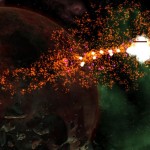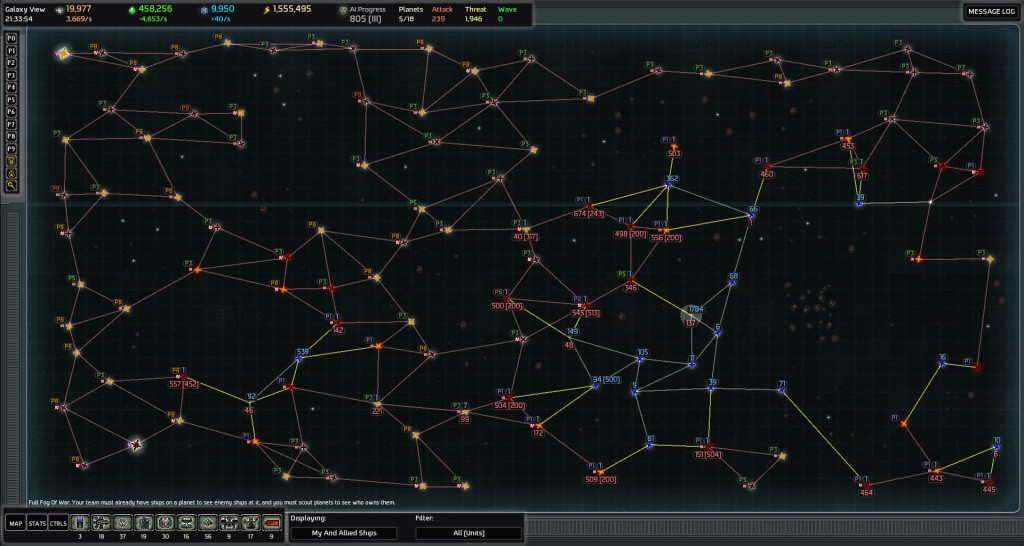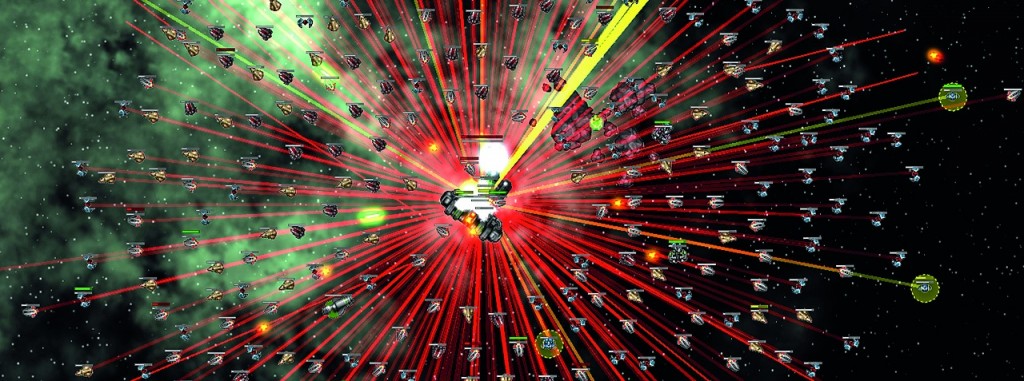 See, when a game concept loves another game concept very much, they do a “special hug” to produce an even cooler and more interesting gaming genre. Back in the day, a spreadsheet was impregnated by a roving atlas only to sire a long line of Paradox Interactive’s unique brand of complex Grand Strategy. Elsewhere, the classic board game of Chess mated with a ‘roided Real Time Strategy to produce a little guy named “Supreme Commander: Forged Alliance”, whom went on to have a fling with Marketing to ultimately dilute its lineage. “Sins of a Solar Empire” was the coddled love-child of a long string of “4X” games whom ultimately decided to go rogue and get rid of the Turn-Based element to their family’s chagrin, and continues with body modifications and facelifts to this day while flirting with and inspiring new types of games. Anyways, Grand Strategy, Forged Alliance, Sins of a Solar Empire, and an internet whore called Turret Defense (who has enough bastard offspring to invade China) all had the notion to have a group orgy and produced the under-appreciated indie game known as “AI War: Fleet Command”.
See, when a game concept loves another game concept very much, they do a “special hug” to produce an even cooler and more interesting gaming genre. Back in the day, a spreadsheet was impregnated by a roving atlas only to sire a long line of Paradox Interactive’s unique brand of complex Grand Strategy. Elsewhere, the classic board game of Chess mated with a ‘roided Real Time Strategy to produce a little guy named “Supreme Commander: Forged Alliance”, whom went on to have a fling with Marketing to ultimately dilute its lineage. “Sins of a Solar Empire” was the coddled love-child of a long string of “4X” games whom ultimately decided to go rogue and get rid of the Turn-Based element to their family’s chagrin, and continues with body modifications and facelifts to this day while flirting with and inspiring new types of games. Anyways, Grand Strategy, Forged Alliance, Sins of a Solar Empire, and an internet whore called Turret Defense (who has enough bastard offspring to invade China) all had the notion to have a group orgy and produced the under-appreciated indie game known as “AI War: Fleet Command”.
You can’t talk about AI War without likening it to any of its progenitors, not because it steals judiciously from their already unique qualities, but because it incorporates their best features in a meaningful way. You have to compare it to these other games because there truly hasn’t been a game that captures this particular mood and mechanics and still retained the “fun” and “replayability” factor as this one did. Massive scale, deep gameplay, varied units, varied gameplay settings, varied strategies, “simple-complexity” where REAL tactics can be implemented without burdening the player with micro-managing, a unique player co-op, and an epic and fulfilling conclusion whether you win or lose. Throw in some attractively-retro graphics and an ill-fitting, yet awesome, soundtrack and you have a prodigy progeny that makes the player wear different “hats” in their bid to outsmart the cold calculation of a murderous computer program (or two).
The main concept is this: Humanity fought each other for centuries across the universe before their Artificial Intelligences, which managed their logistics and armies, ended up joining forces and subsequently turning on their human masters. Beaten, bloody, and reduced to insignificant shreds of its former glory, your pathetic human presence exists on a single planet, from which it plots the usurpation of the massive and unstoppable combined forces of methodical and malevolent AIs. The player is ridiculously over-powered and can be crushed at a moment’s notice, the saving grace being that the AI discounts you as insignificant and delivers its focus elsewhere in the galaxy. Locally, away from the other galaxies the machines rule from, you have two AI mainframe command centers to destroy in the unscouted, randomly-generated, 10-120 world systems. It’s an ocean of sharks, for sure, since each of those many worlds is populated by a standing army of AI-controlled bases more than willing to stamp humanity out for good…. should you become a threat. In the beginning, you are unnoticed, but as time goes by, as you take their planets, as you develop new and devastating weapons, the AI becomes increasingly more aware of the last Hurrah of humanity, and uses much better tactics, more advanced ships, and larger amounts of those ships to blast you to tiny pieces.
That’s the thing: since you don’t want to be noticed, you are forced to use guerilla tactics in order to surprise, outwit, or raid the AI’s armies and bases to clear your self-imposed objectives. The endgame is to cut off both of the AI’s heads, but you simply can’t liberate every world or obliterate their forces with reckless abandon in your quest. The game is specifically engineered to feed you your heart should you attempt a traditional RTS expand-and-conquer approach. To compare, if some rebels steal some of the U.S.’s Smart Cars and blow up a mailbox in Kansas to gain a foothold before marching on D.C., the United States wouldn’t have as visceral of a reaction as if the rebels set off a nuke at Comic-Con, and commandeered New York before attempting an open assault on Congress.
The Uninitiated do not see a sprawling universe of pain.
H’okay. So after you set up what kind of map you want to play on, whether it’s spoked or snake-like or huge or what-not, after you’ve decided what units are non-permissible, what kind of AI tacticians you want to fight against, you start with a single homebase that is crucial to your survival. It is the king in a game of chess, just like the opponent has two kings. If you lose it, the game is over. You have your floating asteroids that supply Metal and Crystal; you have your Energy plants that convert those resources into power; and you have an intangible 3000 Knowledge resource per planet in the galaxy. Fans of typical RTS will be familiar with the typical scouting, base building, and resource gathering elements, maybe even the way that research is performed by “mining” the finite amount of Knowledge from each planet as you go along.
It’s the guerilla warfare that makes you think outside of the box. Take over an AI planet? The AI Progress meter goes up. This entails all the bad stuff directed at you FROM THAT POINT ON, as previously stated. Use high-profile weaponry? The AI Progress meter goes up. Mine knowledge from one of their planets? The AI Progress meter goes up. If you colonize a planet next to an AI planet (and they’re all AI planets), that planet goes on alert, reinforces their borders, and sporadically broadcasts that an ever-advancing technological wave of enemies is heading your direction about 4 minutes before they assault one of your worlds. If you get close to the main AI Cores, they build up a fleet of ships beyond your capabilities and capacity, and THEN send them at you, sometimes in multi-pronged attacks, sometimes in raider-style infiltrations of their own, sometimes dancing circles around you with teleportation, cloaked, or just steam-rolling a chain of your systems with plain ol’ Juggernauts of Destruction. They may head straight for your home. They may crush your mobile defense force. They may simply sit and solidify, becoming much too large for you to ever hope of hurtling, but your limited forces, with a specified cap per design, must find a way to bring the giant down.
So how the hell do you win? First off, it is not shameful to lose to this game, and even losing, buckling as you finally succumb to the unrelenting forces found in AI War, can be a blast of a good time in its own right since the computer not only utilizes human-esque intelligence in late-game as they exploit your weaknesses, but also performs the assaults with mechanical and efficient precision in awe-inspiring genocide. If you’re not playing a game that challenges your way of thinking and constantly forces you to adapt to new elements, new encounters, new tactics, and new ship combinations in a randomly generated galaxy fraught with hidden bonuses and impending danger, you may not be playing a very good game, and certainly not playing one that sparks the rebellious spirit of hope and grit and determination.
No, really. How the hell do you win? The answer is: Carefully. Every boon, every reward or victory comes at the cost of something else. Balance, in all things. Weighing risk and payout. The enemy’s strength is always present, but you can direct it, manipulate it. You will formulate tricky maneuvers that route the forces elsewhere, such as colonizing a planet on the other end of the galaxy you wish to operate from, becoming a strawman for the AI to be distracted with. You might scout and locate a prime target, whether it’s a Core Shield Generator that renders the AI’s Mainframe invincible, or an area-of-effect guard station that would hamper any further progress. Gathering your forces, you leave just enough to keep a back door defended as you load up some transports to blitz across the galaxy, a deep-strike maneuver that leaves you vulnerable, but possibly worth the benefit of felling a pillar of their empire. You might decide your economy is running low or that you simply don’t have enough technically proficient units to compete, so you decide to nab (and defend) a special manufacturing building or AI research station. You might sneak a handful of engineers into a system, setting up shop, an island of hostility in their midst. Or you might exploit a ship combination that provides a special ability and specialized fire as you storm the front. You might strike where they are most defended while they are unorganized, thinning the forces before they decide to head your direction. Or you may devote your resources to setting up “impenetrable” defenses and see if their waves break on your rocks of 10+ turret types plus their upgrades. Guerilla tactics are the point of order, and indeed you feel like a fleshy little bug of a rebel, taking victory where you can, cutting losses where you are made to, and keeping your head down until you are poised for an all-or-nothing last ditch effort to topple the oppressive regime.
Spinier than sea anenomes, your foes will make you weep saltwater.
Besides the great amount of customization of the game’s main parameters to tailor your own experience, you can also tweak the game’s speed and user interface to be more like a classic and slower turn-based experience, or more like a frantic RTS where you send blobs of intelligent forces off on a mission. Surprisingly the game is conducive to both game styles, since ships can be ordered to stay in formation or find the best targets on their own. For a game this large, the micro-management is heavily reduced, though the option to do so is always available. Little flourishes like the asteroids’ auto-building their factories upon colonization and the helpful nature of engineers, reclaim, and clean-up bots go a long way to making managing an interstellar space force easy. (This makes sense, since the one-man programmer/creator had outright stated that he wanted the micro to be tolerable so that the macro wouldn’t suffer.) It’s also worth noting that your ships won’t kill everything in sight and will leave certain high-profile targets for your executive decision.
In general, these types of games are historically infamous for offering multiplayer but delivering a tedious and pain-staking experience that is both difficult to coordinate and to complete when the entire run-through lasts longer than a few hours. AI War breaks that mold with a “Give” feature that allows you to hand over equipment and ships to players that you can easily remove or add to play as it develops. The games are still incredibly long (which I like), but the experience has been streamlined. Yes, if you had an enormous single player session that you wanted to share, you could add a friend, give him ships, and continue the fight. That also means if you start with 4 players and one decides to drop out or dies, you can remove him, replace him, or divy up his stuff. You could also frown his direction and simply give him more units to play around with. Although the game is solely co-op (the enemy AI is the bad guy, after all), this multiplayer thing is a great feature that I can foresee being adopted and implemented by the gaming industry on the whole.
AI War plays like no other RTS that I’ve experienced, as the amalgamation of Grand Strategy (the mindful “big picture” outlook), the annunciation of incoming enemy waves like in typical Turret Defense games, the sheer scale of battles like in modern titles, the incredible AI in all its forms, the chess-master degree of “moves” across the universe, the ease of entering/exiting multiplayer games, the surprising variety of matches that demand you think on your feet, and just simply the originality of it all makes this a title worth seeing. AI War: Fleet Command will certainly be insurmountable for many players out there but if a game makes the process of losing fun, how can you lose? Steam, Arcen Games (the developer), and [maybe] even Stardock are now practically giving it away for 17 bucks for both the main game and three expansions. And this price does not include any marketing discounts which had previously cut the cost by 75% a few months back.
If you don’t buy this game or check out either the youtube videos or the 3 hour downloadable demo, at least spread the word to help give support to a budding developer with fresh ideas. Stamp out ignorance! Train yourself on how to oppose our future AI overlords! Viva la resistance!




Pingback: Busy Schedule For The Remainder Of 2012 | Arcen Games